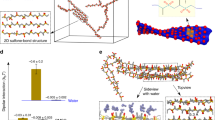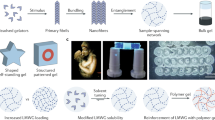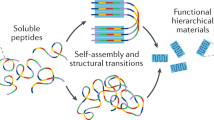Abstract
Supramolecular gels, which demonstrate tunable functionalities, have attracted much interest in a range of areas, including healthcare, environmental protection and energy-related technologies. Preparing these materials in a reliable manner is challenging, with an increased level of kinetic defects observed at higher self-assembly rates. Here, by combining biocatalysis and molecular self-assembly, we have shown the ability to more quickly access higher-ordered structures. By simply increasing enzyme concentration, supramolecular order expressed at molecular, nano- and micro-levels is dramatically enhanced, and, importantly, the gelator concentrations remain identical. Amphiphile molecules were prepared by attaching an aromatic moiety to a dipeptide backbone capped with a methyl ester. Their self-assembly was induced by an enzyme that hydrolysed the ester. Different enzyme concentrations altered the catalytic activity and size of the enzyme clusters, affecting their mobility. This allowed structurally diverse materials that represent local minima in the free energy landscape to be accessed based on a single gelator structure.
This is a preview of subscription content, access via your institution
Access options
Subscribe to this journal
Receive 12 print issues and online access
$259.00 per year
only $21.58 per issue
Buy this article
- Purchase on Springer Link
- Instant access to full article PDF
Prices may be subject to local taxes which are calculated during checkout



Similar content being viewed by others
References
Estroff, L. A. & Hamilton, A. D. Water gelation by small organic molecules. Chem. Rev. 104, 1201–1217 (2004).
Lehn, J. M. Supramolecular Chemistry—Concepts and Perspectives (VCH Weinheim, 1995).
Whitesides, G. M. & Boncheva, M. Beyond molecules: self-assembly of mesoscopic and macroscopic components. Proc. Natl Acad. Sci. USA 99, 4769–4774 (2002).
Hirst, A. R. et al. High-tech applications of self-assembling supramolecular nanostructured gel-phase materials: from regenerative medicine to electronic devices. Angew. Chem. Int. Ed. 47, 8002–8018 (2008).
Capito, R. M., Azevedo, H. S., Velichko, Y. S., Mata, A. & Stupp, S. I. Self-assembly of large and small molecules into hierarchically ordered sacs and membranes. Science 319, 1812–1816 (2008).
Wang, Q. et al. High-water-content mouldable hydrogels by mixing clay and a dendritic molecular binder. Nature 463, 339–343 (2010).
Kiyonaka, S. et al. Semi-wet peptide/protein array using supramolecular hydrogel. Nature Mater. 3, 58–64 (2004).
Jonkheijm, P., van der Schoot, P., Schenning, A. P. H. J. & Meijer, E. W. Probing the solvent-assisted nucleation pathway in chemical self-assembly. Science 313, 80–83 (2006).
Lloyd, G. O. & Steed, J. W. Anion-tuning of supramolecular gel properties. Nature Chem. 1, 437–442 (2009).
Carnall, J. M. A. et al. Mechanosensitive self-replication driven by self-organization. Science 327, 1502–1506 (2010).
Cui, H. et al. Spontaneous and X-ray triggered crystallization at long range in self-assembling filament networks. Science 327, 555–559 (2010).
Winkler, S., Wilson, D. & Kaplan, D. L. Controlling β-sheet assembly in genetically engineered silk by enzymatic phosphorylation/dephosphorylation. Biochemistry 39, 12739–12746 (2000).
Hu, B. H. & Messersmith, P. B. Rational design of transglutaminase substrate peptides for rapid enzymatic formation of hydrogels. J. Am. Chem. Soc. 125, 14298–14299 (2003).
Yang, Z. M. et al. Enzymatic formation of supramolecular hydrogels. Adv. Mater. 16, 1440–1444 (2004).
Um, S. H. et al. Enzyme-catalysed assembly of DNA hydrogel. Nature Mater. 5, 797–801 (2006).
Williams, R. J. et al. Enzyme-assisted self-assembly under thermodynamic control. Nature Nanotech. 4, 19–24 (2009).
Adler-Abramovich, L., Perry, R., Sagi, A., Gazit, E. & Shabat D. Controlled assembly of peptide nanotubes triggered by enzymatic activation of self-immolative dendrimers. ChemBioChem 8, 859–862 (2007).
Cui, H., Chen, Z., Zhong, S., Wooley, K. L. & Pochan, D. J. Block copolymer assembly via kinetic control. Science 317, 647–650 (2007).
Yamamoto, T. et al. Stabilization of a kinetically favored nanostructure: surface ROMP of self-assembled conductive nanocoils from a norbornene-appended hexa-peri-hexabenzocoronene. J. Am. Chem. Soc. 128, 14337–14340 (2006).
Haines-Butterick, L. et al. Controlling hydrogelation kinetics by peptide design for three-dimensional encapsulation and injectable delivery of cells. Proc. Natl Acad. Sci. USA 104, 7791–7796 (2007).
Zhang, S. Fabrication of novel materials through molecular self-assembly. Nature Biotechnol. 21, 1171–1178 (2003).
Banwell, E. F. et al. Rational design and application of responsive alpha-helical peptide hydrogels. Nature Mater. 8, 596–600 (2009).
Adler-Abramovich, L. et al. Self-assembled arrays of peptide nanotubes by vapour deposition. Nature Nanotech. 4, 849–854 (2009).
Smith, A. M. et al. Fmoc-diphenylalanine self assembles to a hydrogel via a novel architecture based on pi−pi interlocked beta-sheets. Adv. Mater. 20, 37–41 (2008).
Zhang, Y., Gu, H., Yang, Z. & Xu, B. Supramolecular hydrogels respond to ligand−receptor interaction. J. Am. Chem. Soc. 125, 13680–13681 (2003).
Keller, D. & Bustamante, C. Theory of the interaction of light with large inhomogeneous molecular aggregates. II. psi-type circular dichroism. J. Chem. Phys. 84, 2972–2980 (1986).
Martin, J. E. & Wilcoxon, J. P. Critical dynamics of the sol–gel transition. Phys. Rev. Lett. 61, 373–376 (1988).
Fang, L., Brown, W. & Konak, C. Dynamic light scattering study of the sol–gel transition. Macromolecules 24, 6839–6842 (1991).
Weijers, M., Visschers, R. W. & Nicolai, T. Light scattering study of heat-induced aggregation and gelation of ovalbumin. Macromolecules 35, 4753–4762 (2002).
Yamamoto, Y. et al. Photoconductive coaxial nanotubes of molecularly connected electron donor and acceptor Layers. Science 314, 1761–1764 (2006).
Schenning, A. P. H. J. & Meijer, E. W. Supramolecular electronics; nanowires from self-assembled π-conjugated systems. Chem. Commun. 26, 3245–3258 (2005).
Xu, H. et al. An investigation of the conductivity of peptide nanotube networks prepared by enzyme-triggered self-assembly. Nanoscale 2, 960–966 (2010).
Ashkenasy, N., Seth Horne, W. & Ghadiri, M. R. Design of self-assembling peptide nanotubes with delocalized electronic states. Small 2, 99–102 (2006).
Acknowledgements
The authors acknowledge the Engineering and Physical Sciences Research Council (EPSRC), Human Frontiers Science Programme (HFSP) and the Leverhulme Trust (UK) for funding. The authors also thank L. Birchall and P.F. Caponi for assistance with graphics.
Author information
Authors and Affiliations
Contributions
A.R.H., S.R., J.S., S.S. and R.V.U. conceived and designed the experiments. A.R.H., S.R., M.A., A.K.D., N.H., N.J. and J.B. performed the experiments. A.R.H., S.R., P.M., J.S., S.S. and R.V.U. analysed the data. S.M., J.H.v.E. and N.T.H. contributed materials/analysis tools. A.R.H., S.R., S.S. and R.V.U. co-wrote the paper.
Corresponding author
Ethics declarations
Competing interests
The authors declare no competing financial interests.
Supplementary information
Supplementary information
Supplementary information (PDF 1099 kb)
Rights and permissions
About this article
Cite this article
Hirst, A., Roy, S., Arora, M. et al. Biocatalytic induction of supramolecular order. Nature Chem 2, 1089–1094 (2010). https://doi.org/10.1038/nchem.861
Received:
Accepted:
Published:
Issue Date:
DOI: https://doi.org/10.1038/nchem.861
This article is cited by
-
Chirality and energy transfer amplified circularly polarized luminescence in composite nanohelix
Nature Communications (2017)
-
Facile Control over the Supramolecular Ordering of Self-assembled Peptide Scaffolds by Simultaneous Assembly with a Polysacharride
Scientific Reports (2017)
-
Thermally bisignate supramolecular polymerization
Nature Chemistry (2017)
-
Non-equilibrium steady states in supramolecular polymerization
Nature Communications (2017)



